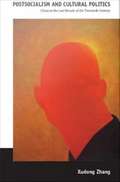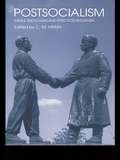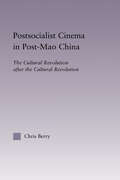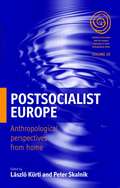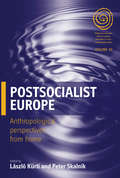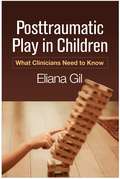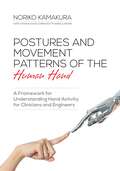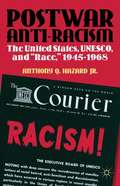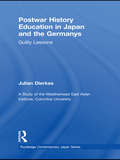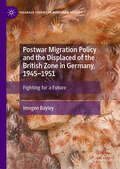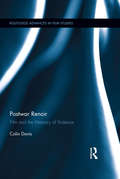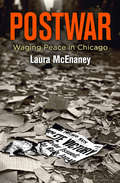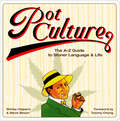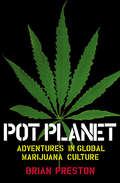- Table View
- List View
Postsocialism and Cultural Politics: China in the Last Decade of the Twentieth Century
by Xudong ZhangIn Postsocialism and Cultural Politics, Xudong Zhang offers a critical analysis of China's "long 1990s," the tumultuous years between the 1989 Tiananmen Square crackdown and China's entry into the World Trade Organization in 2001. The 1990s were marked by Deng Xiaoping's market-oriented reforms, the Taiwan missile crisis, the Asian financial crisis, and the end of British colonial rule of Hong Kong. Considering developments including the state's cultivation of a market economy, the aggressive neoliberalism that accompanied that effort, the rise of a middle class and a consumer culture, and China's entry into the world economy, Zhang argues that Chinese socialism is not over. Rather it survives as postsocialism, which is articulated through the discourses of postmodernism and nationalism and through the co-existence of multiple modes of production and socio-cultural norms. Highlighting China's uniqueness, as well as the implications of its recent experiences for the wider world, Zhang suggests that Chinese postsocialism illuminates previously obscure aspects of the global shift from modernity to postmodernity. Zhang examines the reactions of intellectuals, authors, and filmmakers to the cultural and political conflicts in China during the 1990s. He offers a nuanced assessment of the changing divisions and allegiances within the intellectual landscape, and he analyzes the postsocialist realism of the era through readings of Mo Yan's fiction and the films of Zhang Yimou. With Postsocialism and Cultural Politics, Zhang applies the same keen insight to China's long 1990s that he brought to bear on the 1980s in Chinese Modernism in the Era of Reforms.
Postsocialism: Ideals, ideologies and practices in Eurasia
by C. M. HannSocial scientists did not predict the collapse of the socialist system in 1989-91 and their attempts to explain postsocialism have not been comprehensive. Economic disintegration and political instability have been documented, but the deeper causes have often gone unnoticed. Consequently the solutions proffered, such as the promotion of non-governmental organisations as the foundations of 'civil society', have so far brought little success.Postsocialism presents, for the first time, the anthropological responses to these problems which are all grounded in intensive fieldwork. The authors demonstrate that even when local conditions are specific, the view 'from below' illuminates macro trends. A wide range of topics are discussed, including:*the role of social and cultural capital in determining the 'winners' of rural decollectivization*the devaluation of blue collar labour*the position of Gypsies*the viability of 'multicultural' models in situations of religious differences and ethnic violence*new patterns of consumption in China*the revival of rituals and the healing of socialist 'trauma'. _
Postsocialist Cinema in Post-Mao China: The Cultural Revolution after the Cultural Revolution (East Asia: History, Politics, Sociology and Culture)
by Chris BerryThis book argues that the fundamental shift in Chinese Cinema away from Socialism and towards Post-Socialism can be located earlier than the emergence of the "Fifth Generation" in the mid-eighties when it is usually assumed to have occured. By close analysis of films from the 1949-1976 Maoist era in comparison with 1976-81 films representing the Cultural Revolution, it demonstrates that the latter already breaks away from Socialism.
Postsocialist Europe
by Laszlo Kürti Peter SkalnikNow that nearly twenty years have passed since the collapse of the Soviet bloc there is a need to understand what has taken place since that historic date and where we are at the moment. Bringing together authors with different historical, cultural, regional and theoretical backgrounds, this volume engages in debates that address new questions arising from recent developments, such as whether there is a need to reject or uphold the notion of post-socialism as both a necessary and valid concept ignoring changes and differences across both time and space. The authors' firsthand ethnographies from their own countries belie such a simplistic notion, revealing, as they do, the cultural, social, and historical diversity of countries of Central and Southeastern Europe.
Postsocialist Europe
by La¡szla³ Kuirti Peter SkalnakNow that nearly twenty years have passed since the collapse of the Soviet bloc there is a need to understand what has taken place since that historic date and where we are at the moment. Bringing together authors with different historical, cultural, regional and theoretical backgrounds, this volume engages in debates that address new questions arising from recent developments, such as whether there is a need to reject or uphold the notion of post-socialism as both a necessary and valid concept ignoring changes and differences across both time and space. The authors' firsthand ethnographies from their own countries belie such a simplistic notion, revealing, as they do, the cultural, social, and historical diversity of countries of Central and Southeastern Europe.
Posttraumatic Play in Children: What Clinicians Need to Know
by Eliana GilFrom leading expert Eliana Gil, this book provides child clinicians with essential knowledge and tools for evaluating and working with posttraumatic play. Such play, which is often repetitive and disturbing, may help resolve traumatic experiences--but can also become toxic. The book guides the clinician to determine what is going on with a given child and intervene sensitively and effectively. Evocative case material is interwoven with up-to-date information on the developmental impact of trauma and ways to facilitate children's natural reparative capacities. A reproducible assessment checklist to help clinicians differentiate between useful and dangerous posttraumatic play can be downloaded and printed in a convenient 8 1/2" x 11" size.
Postures and Movement Patterns of the Human Hand: A Framework for Understanding Hand Activity for Clinicians and Engineers
by Noriko KamakuraThink of the complexity of ordinary hand activity and how to describe it all, both precisely and concisely. The author, a noted occupational therapist in Japan, offers a disciplined approach to doing just that. Whereas research has heretofore been limited
Postwar Anti-racism
by Anthony Q. HazardThis book explores the discourse and practice of anti-racism in the first two decades following World War II, uncovering the ways scientific and cultural discourses of 'race' continued to circulate in the early period of contemporary globalization through the lens on UNESCO.
Postwar History Education in Japan and the Germanys: Guilty Lessons (Routledge Contemporary Japan Series)
by Julian DierkesHow did East and West Germany and Japan reconstitute national identity after World War II? Did all three experience parallel reactions to national trauma and reconstruction? History education shaped how these nations reconceived their national identities. Because the content of history education was controlled by different actors, history education materials framed national identity in very different ways. In Japan, where the curriculum was controlled by bureaucrats bent on maintaining their purported neutrality, materials focused on the empirical building blocks of history (who? where? what?) at the expense of discussions of historical responsibility. In East Germany, where party cadres controlled the curriculum, students were taught that World War II was a capitalist aberration. In (West) Germany, where teachers controlled the curriculum, students were taught the lessons of shame and then regeneration after historians turned away from grand national narratives. This book shows that constructions of national identity are not easily malleable on the basis of moral and political concerns only, but that they are subject to institutional constraints and opportunities. In an age when post-conflict reconstruction and reconciliation has become a major focus of international policies, the analysis offers important implications for the parallel revision of portrayals of national history and the institutional reconstruction of policy-making regimes.
Postwar Migration Policy and the Displaced of the British Zone in Germany, 1945–1951: Fighting for a Future (Palgrave Studies in Migration History)
by Imogen BayleyThis book examines the experiences of refugees who populated the Displaced Persons (DP) camps in the British Zone of Allied-occupied Germany after the Second World War. With a specific focus on Polish and Jewish communities, it explores the interaction between migration policy and the migration strategy of refugees - or in other words – the relationship between DP policy and individual choices, and how these evolved over time. The book aims to harmonize often contradictory images of displaced persons in the British Zone of occupation by taking a comparative approach and analysing conflicting identifications and state-individual relations. Drawing on the records of the International Tracing Service, refugee memoirs, DP publications distributed in the camps themselves, and personal petitions and correspondences, the author sheds light on the experiences of displaced persons and illustrates the difficulty of making clear-cut distinctions between forced and voluntary migration. Today, as in the post-war period, refugees’ access to social rights and welfare, settlement rights, and the possibility of family reunification, can all be determined by the same labels that were so fiercely contested after 1945. A dichotomy between so-called ‘economic’ and ‘political’ migration endures, and many claims to asylum are today rejected on the grounds of applicants not being formally recognized as ‘genuine’ refugees and recipients of aid. This book therefore adds to our growing understanding of the plight of refugees and the need to ensure access to justice for all through the ongoing building of an effective, accountable, and inclusive refugee regime.
Postwar Renoir: Film and the Memory of Violence (Routledge Advances in Film Studies)
by Colin DavisThis book re-assesses director Jean Renoir’s work between his departure from France in 1940 and his death in 1979, and contributes to the debate over how the medium of film registers the impact of trauma. The 1930s ended in catastrophe for both for Renoir and for France: La Règle du jeu was a critical and commercial disaster on its release in July 1939 and in 1940 France was occupied by Germany. Even so, Renoir continued to innovate and experiment with his post-war work, yet the thirteen films he made between 1941 and 1969, constituting nearly half of his work in sound cinema, have been sorely neglected in the study of his work. With detailed readings of the these films and four novels produced by Renoir in his last four decades, Davis explores the direct and indirect ways in which film, and Renoir’s films in particular, depict the aftermath of violence.
Postwar: Waging Peace in Chicago (Politics and Culture in Modern America)
by Laura McEnaneyWhen World War II ended, Americans celebrated a military victory abroad, but the meaning of peace at home was yet to be defined. From roughly 1943 onward, building a postwar society became the new national project, and every interest group involved in the war effort—from business leaders to working-class renters—held different visions for the war's aftermath. In Postwar, Laura McEnaney plumbs the depths of this period to explore exactly what peace meant to a broad swath of civilians, including apartment dwellers, single women and housewives, newly freed Japanese American internees, African American migrants, and returning veterans. In her fine-grained social history of postwar Chicago, McEnaney puts ordinary working-class people at the center of her investigation.What she finds is a working-class war liberalism—a conviction that the wartime state had taken things from people, and that the postwar era was about reclaiming those things with the state's help. McEnaney examines vernacular understandings of the state, exploring how people perceived and experienced government in their lives. For Chicago's working-class residents, the state was not clearly delineated. The local offices of federal agencies, along with organizations such as the Travelers Aid Society and other neighborhood welfare groups, all became what she calls the state in the neighborhood, an extension of government to serve an urban working class recovering from war. Just as they had made war, the urban working class had to make peace, and their requests for help, large and small, constituted early dialogues about the role of the state during peacetime.Postwar examines peace as its own complex historical process, a passage from conflict to postconflict that contained human struggles and policy dilemmas that would shape later decades as fatefully as had the war.
Pot Culture: The A–Z Guide to Stoner Language & Life
by Steve Bloom Shirley Halperin“Essentially an encyclopedia of pot, filled with such top 10 lists as ‘best stoner movies’ . . . plus a ‘pot-parazzi’ section with celebrities sneaking a toke.” —BillboardDo you know the difference between burning one and Burning Man? Does using the name Marley as an adjective make total sense to you? Do you chuckle to yourself when the clock strikes 4:20? Are you convinced that the movie Dazed and Confused deserved an Oscar? If you answered “Dude!” to any of these questions, then Pot Culture is the book you’ve been waiting for. For those in the know, it’s the stoner bible. For novices, it’s Pot 101. Either way, Pot Culture encapsulates the history, lifestyle, and language of a subculture that, with every generation, is constantly redefining itself. From exhaustive lists of stoner-friendly movies, music, and television shows to detailed explanations of various stoner tools to celebrity-authored how-tos and an A-Z compendium of slang words and terms, it’s the ultimate encyclopedia of pot. Written by former High Times editors Shirley Halperin (now a senior writer at Entertainment Weekly and a TV talking head) and Steve Bloom (publisher of CelebStoner.com), and featuring contributions by a host of celebrity stoners, including Melissa Etheridge, Maroon 5’s Adam Levine, Redman, Steve-O, and America’s Next Top Model’s Adrianne Curry, Pot Culture provides the answers to everything you ever wanted to know about pot but were too stoned to ask.“This is a fun book that every toker should get their sticky green fingers on. Clever and informative . . . Great book and a must-buy for all us loadies.” —Blogcritics
Pot Planet: Adventures in Global Marijuana Culture
by Brian Preston“A gimlet-eyed and often hilarious account of the author’s round-the-world reefer safari . . . A surprisingly clear-headed view of potheads worldwide” (The New Yorker). In Pot Planet, journalist Brian Preston sets out on a global ganja safari to explore strange new cannabis cultures, to seek out new growers, activists, and other reefer revolutionaries . . . and to boldly get baked with each of them. Preston’s journeys take him across every strata of pot cultivation and enjoyment. In the Canadian Kootenays, he meets hemp farmers struggling to harvest their crop on the fringes of legitimacy. In Cambodia and Morocco, he explores the final frontiers of Third World weed enthusiasts. In northern California, he takes a clear-eyed look at the medicinal marijuana movement, seeing both its promises and its problems. In England, Switzerland, and Spain, he observes grudging governments catching up to public tolerance. And at the Cannabis Cup in Amsterdam, he joins in the raucous multiday tasting competition and celebration at the international summit of the best breeders, growers, and connoisseurs in the world. Part investigative travelogue, part cultural history, part polemic for the unfettered enjoyment of nature’s most perfect and pleasing herb, Pot Planet is an unforgettable odyssey into the multifaceted world of hemp, full of wit, insight, and inspiration. “Fun to read, gallops along and, should you like to embark on such an odyssey yourself, might even serve as a guide . . . [or] an intoxicated mystery tour.” —Salon “A marvelously entertaining, well-written and probing look at the world though marijuana . . . Throughout, Preston proves himself to be both an intrepid traveler and a fine storyteller.” —Publishers Weekly
Pot for Profit: Cannabis Legalization, Racial Capitalism, and the Expansion of the Carceral State (The Cultural Lives of Law)
by Joseph MelloThe United States has experienced a dramatic shift in attitudes towards cannabis use from the 1970s, when only 12% of Americans said that they thought that cannabis should be legal, to today. What once had been a counterculture drug supplied for the black market by socially marginal figures like drug smugglers and hippies has become a big business, dominated by a few large corporations. Pot for Profit, traces the cultural, historical, political, and legal roots of these changing attitudes towards cannabis. The book also showcases interviews with dispensary owners, bud tenders, and other industry employees about their experience working in the legal cannabis industry, and cannabis reform activists working towards legalization. Mello argues that embracing the profit potential of this drug has been key to the success of cannabis reform, and that this approach has problematic economic and racial implications. The story of cannabis reform shows that neoliberalism may not be an absolute barrier to social change, but it does determine the terrain on which these debates must occur. When activists capitulate to these pressures, they may make some gains, but those gains come with strings attached. This only serves to reinforce the totalizing power of the neoliberal ethos on American life. The book concludes by meditating on what, if anything, can be done to move the cannabis legalization movement back onto a more progressive track.
Potboilers: Methods, Concepts and Case Studies in Popular Fiction (Communication and Society)
by Jerry Palmer Mr Jerry PalmerPotboilers looks at the many forms of popular narrative - in print, film and TV. It considers the ways in they have been analysed in literary criticism, sociology, communications, media and cultural studies. The book introduces and summarizes two decades of debate about mass-produced fictions and their position within popular culture. It assesses the methods that have been used in these debates, focussing both on narrative analysis and the communications process. It explores generic conventions, the role of commercial strategies, and the nature of the audience with reference to crime fiction, soap opera, romance and TV sitcom. Distinctions between `high' and `low' culture have relegated many popular forms to the trash-can of `great' literature. This book takes stock of the methods and concepts used to analyse popular culture and argues for a non-elitist approach to the study of literature, film and television.
Potential Health Risks to DOD Firing-Range Personnel from Recurrent Lead Exposure
by Division On Earth Life StudiesLead is a ubiquitous metal in the environment, and its adverse effects on human health are well documented. Lead interacts at multiple cellular sites and can alter protein function in part through binding to amino acid sulfhydryl and carboxyl groups on a wide variety of structural and functional proteins. In addition, lead mimics calcium and other divalent cations, and it induces the increased production of cytotoxic reactive oxygen species. Adverse effects associated with lead exposure can be observed in multiple body systems, including the nervous, cardiovascular, renal, hematologic, immunologic, and reproductive systems. Lead exposure is also known to induce adverse developmental effects in utero and in the developing neonate. Lead poses an occupational health hazard, and the Occupational Safety and Health Administration (OSHA) developed a lead standard for general industry that regulates many workplace exposures to this metal. The standard was promulgated in 1978 and encompasses several approaches for reducing exposure to lead, including the establishment of a permissible exposure limit (PEL) of 50 μg/m3 in air (an 8-hour time-weighted average [TWA]), exposure guidelines for instituting medical surveillance, guidelines for removal from and return to work, and other risk-management strategies. An action level of 30 μg/m3 (an 8-hour TWA) for lead was established to trigger medical surveillance in employees exposed above that level for more than 30 days per year. Another provision is that any employee who has a blood lead level (BLL) of 60 μg/dL or higher or three consecutive BLLs averaging 50 μg/dL or higher must be removed from work involving lead exposure. An employee may resume work associated with lead exposure only after two BLLs are lower than 40 μg/dL. Thus, maintaining BLLs lower than 40 μg/dL was judged by OSHA to protect workers from adverse health effects. The OSHA standard also includes a recommendation that BLLs of workers who are planning a pregnancy be under 30μg/dL. In light of knowledge about the hazards posed by occupational lead exposure, the Department of Defense (DOD) asked the National Research Council to evaluate potential health risks from recurrent lead exposure of firing-range personnel. Specifically, DOD asked the National Research Council to determine whether current exposure standards for lead on DOD firing ranges protect its workers adequately. The committee also considered measures of cumulative lead dose. Potential Health Risks to DOD Firing-Range Personnel from Recurrent Lead Exposure will help to inform decisions about setting new air exposure limits for lead on firing ranges, about whether to implement limits for surface contamination, and about how to design lead-surveillance programs for range personnel appropriately.
Potential-Based Analysis of Social, Communication, and Distributed Networks
by Seyed Rasoul EtesamiThis work makes major contributions to the thriving area of social, communication, and distributed networks by introducing novel methodologies and tools toward the study of the evolutionary behaviors of these networks, as well as their computational complexity and rates of convergence. By departing from the classical approaches and results in the literature, this work shows that it is possible to handle more complex and realistic nonlinear models where either the traditional approaches fail or lead to weak results. The author also develops several easily implementable algorithms, delivering excellent performance guarantees while running faster than those that exist in the literature. The study undertaken and the approaches adopted enable the analysis of the evolution of several different types of social and distributed networks, with the potential to apply to and resolve several other outstanding issues in such networks.
Potentialities: Collected Essays in Philosophy (Meridian: Crossing Aesthetics)
by Giorgio AgambenThis book collects fifteen major philosophical essays spanning more than twenty years by acclaimed Italian philosopher and author of State of Exception.Giorgio Agamben is one of contemporary philosophy’s most influential thinkers on the subjects of language, power, society. This collection of essays opens with an enlightening introduction by the translator Daniel Heller-Roazen, who situates Agamben’s work with respect to both the history of philosophy and contemporary European thought. The essays that follow articulate a series of theoretical confrontations with privileged figures in the history of philosophy, politics, and criticism, from Plato to Spinoza, Aristotle to Deleuze, Carl Schmitt to Benjamin, Hegel to Aby Warburg, and Heidegger to Derrida. Three fundamental concepts organize the collection as a whole: the existence of language; the nature of history; and the problem of potentiality in metaphysics, ethics, and the philosophy of language. All these topics converge in the final part of the book, in which Agamben offers an extensive reading of Melville’s short story “Bartleby the Scrivener” as a work that puts potentiality and actuality, possibility and reality, in a new light.
Potenziale der Digitalisierung für die Teilhabe von Menschen mit Behinderung: Eine anwendungsbezogene Praxisforschung im Alltag (Dortmunder Beiträge zur Sozialforschung)
by Ann Christin SchulzDigitalisierung betrifft alle Lebensbereiche. Aber nicht alle Personen können diesem Prozess adäquat begegnen und sie werden zunehmend aus der Gesellschaft ausgeschlossen. Ihnen droht also (digitale) Exklusion. Besonders im Jahr 2020 erlangte die Digitalisierung durch die Coronavirus-Pandemie einen Aufwind, indem eine Vielzahl analoger Praktiken in den digitalen Raum verlagert wurden. Dadurch entstanden Chancen auf Teilhabe, jedoch stieg auch die Gefahr der Exklusion - besonders für Personen, die prädisponiert für Marginalisierung sind, wie die in diesem Buch zugrundeliegende Zielgruppe "Menschen mit geistigen Behinderungen" (MmgB). Aufgrund dessen ist es erforderlich, die gesellschaftliche Teilhabe zu untersuchen. Ann Christin Schulz stützt sich dabei auf den sozialen Transformationsprozess der Digitalisierung. Im Vordergrund steht die subjektorientierte Betrachtungsebene mit einem praxistheoretischen Ansatz, indem in Form von Beobachtungen und eingebetteter Forschung ein Jahr in einer Einrichtung einer Behindertenhilfe geforscht wurde. Die Autorin zeigt u.a., welche Chancen und Risiken Digitalisierung für die Teilhabe von MmgB bietet, welche sozialen Praktiken sich mit digitalen Technologien entfalten und welcher Einfluss der soziale Kontext von MmgB auf ihre Teilhabe hat.
Potenziale entfalten und organisationale Routinen gestalten: Migranten als multikulturelle Individuen und interkulturelle Aushandlung in verschiedenen Organisationskontexten
by Sina GrosskopfDieses Buch beschäftigt sich mit Migranten als multikulturelle Individuen, die durch die Sozialisierung in verschiedenen Ländern ein erweitertes kulturelles Repertoire aufweisen. Dieses Repertoire stellt Potenziale im Arbeitskontext, die von Organisationen selten erkannt und deshalb auch nicht in strategische Ressourcen umgewandelt werden können. Anhand von vier qualitativen Fallstudien der Luft- und Raumfahrt und Unternehmensberatung in Deutschland zeigt das Buch, dass multikulturelle Individuen organisationale Routinen aufbrechen und in interkulturellen Aushandlungen mit Teamkollegen kreativ Veränderung und Innovation herbeiführen. Dabei beeinflusst der organisationale Kontext die Veränderungsspielräume und -funktionen. So wird ein theoretischer Beitrag zu Kompetenzen multikultureller Individuen geleistet, sowie ein praktischer Beitrag für die Personal- und Organisationsentwicklung, ebenso wie ein methodischer Beitrag durch die Reflexion des induktiv-abduktiven Forschungsprozesses und die Erkenntnisse zur Verbindung von Grounded Theory und Fallstudien.
Potenziale von Bewegung, Spiel und Sport für ein gesundes Aufwachsen in Deutschland: Ergebnisse aus dem Projekt 'Move for Health' (Bildung und Sport #35)
by Nils Neuber Ulrike Burrmann Bettina Rulofs Dennis Dreiskämper Miriam Kehne Jessica Süßenbach Gunda Voigts Lena HenningDer Band gibt einen Überblick über die Ergebnisse des Projekts 'Move for Health' und ordnet sie in den aktuellen Diskurs zur Bedeutung von Bewegung, Spiel und Sport im Kindesalter ein. Untersucht wurden drei Themenfelder: Die psycho-soziale Gesundheit von Kindern und Jugendlichen und das Potenzial von Bewegung, Spiel und Sport, der Sportverein als attraktive Lebenswelt im Aufwachsen und Gelingensbedingungen für das Sporttreiben von sozial benachteiligten und sportfernen Gruppen. Dies ist ein Open-Access-Buch.
Potholes in the Road: Transition Problems for Low-Income Youth in High School
by Martin Sanchez-JankowskiEducation has been increasingly lauded as the path to achieving the American Dream, and in this book Martín Sánchez-Jankowski uses extensive ethnographic research to explore the dynamics of the interrelated barriers that low-income students must surpass in order to make transitions successfully from high school to college. With rigor and compassion, and engaging in participant observation to examine how individual students confront the education system, Potholes in the Road shows how obstacles related to issues of structure, culture, and agency make achieving the American Dream through education particularly challenging.
Potlatch as Pedagogy: Learning Through Ceremony
by Robert Davidson Sara Florence DavidsonIn 1884, the Canadian government enacted a ban on the potlatch, the foundational ceremony of the Haida people. The tradition, which determined social structure, transmitted cultural knowledge, and redistributed wealth, was seen as a cultural impediment to the government&’s aim of assimilation.The tradition did not die, however; the knowledge of the ceremony was kept alive by the Elders through other events until the ban was lifted. In 1969, a potlatch was held. The occasion: the raising of a totem pole carved by Robert Davidson, the first the community had seen in close to 80 years. From then on, the community publicly reclaimed, from the Elders who remained to share it, the knowledge that has almost been lost.Sara Florence Davidson, Robert&’s daughter, would become an educator. Over the course of her own education, she came to see how the traditions of the Haida practiced by her father—holistic, built on relationships, practical, and continuous—could be integrated into contemporary educational practices. From this realization came the roots for this book.
Potlatch as Pedagogy: Learning Through Ceremony
by Robert Davidson Sara Florence DavidsonIn 1884, the Canadian government enacted a ban on the potlatch, the foundational ceremony of the Haida people. The tradition, which determined social structure, transmitted cultural knowledge, and redistributed wealth, was seen as a cultural impediment to the government&’s aim of assimilation.The tradition did not die, however; the knowledge of the ceremony was kept alive by the Elders through other events until the ban was lifted. In 1969, a potlatch was held. The occasion: the raising of a totem pole carved by Robert Davidson, the first the community had seen in close to 80 years. From then on, the community publicly reclaimed, from the Elders who remained to share it, the knowledge that has almost been lost.Sara Florence Davidson, Robert&’s daughter, would become an educator. Over the course of her own education, she came to see how the traditions of the Haida practiced by her father—holistic, built on relationships, practical, and continuous—could be integrated into contemporary educational practices. From this realization came the roots for this book.
